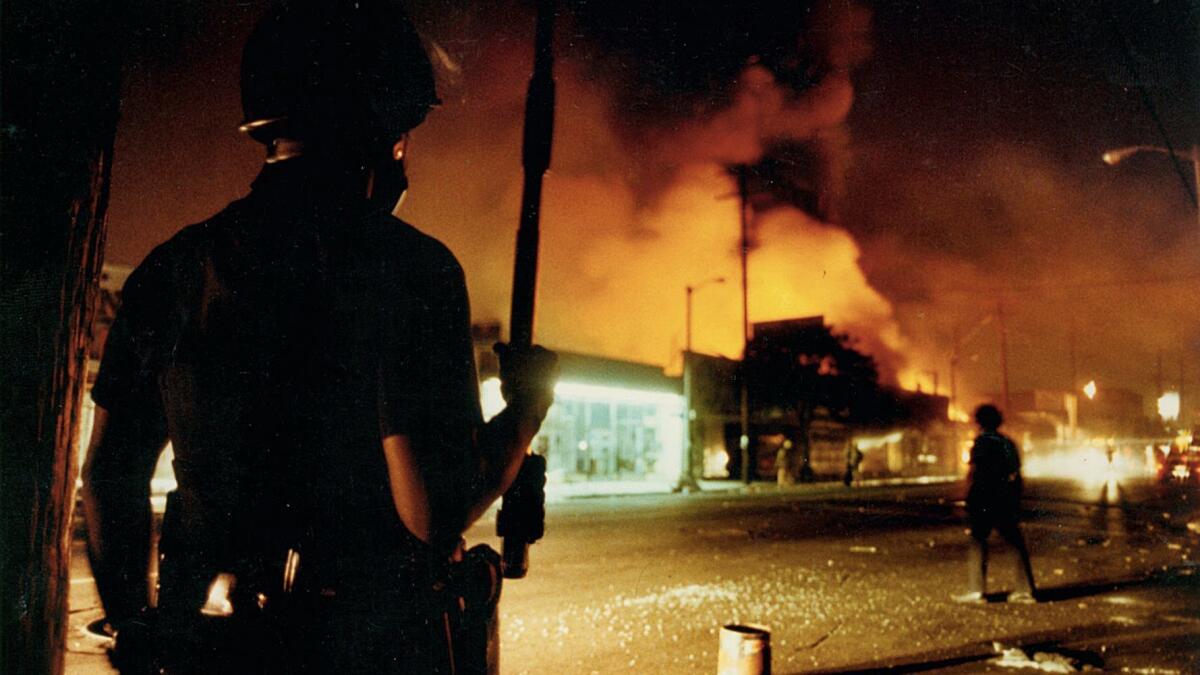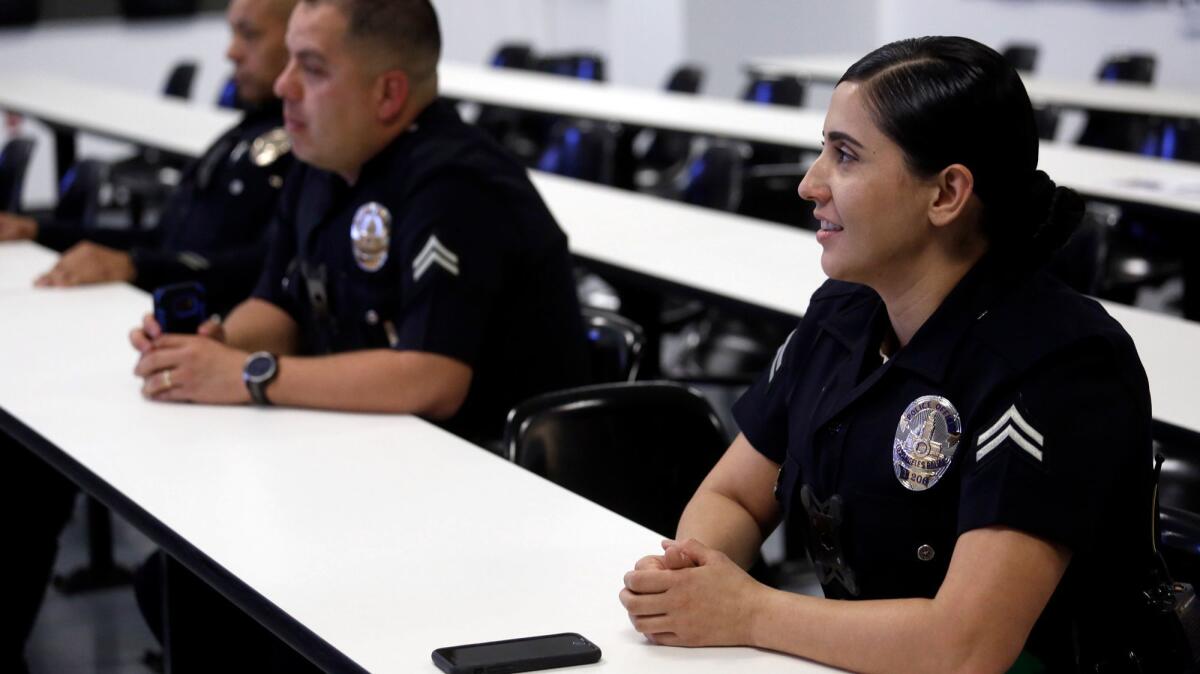Young LAPD officers barely remember 1992 riots, but work in a department shaped by the unrest

Officer Nancy Rodriguez is far too young to have been on duty during the 1992 Los Angeles riots.
Her most vivid memory of that time is of a pink party dress.
She was 4 years old. She had recently worn the dress to her birthday party. It was at a dry cleaner near her home in South Los Angeles, and she never saw it again. Rioters set the store on fire.

Her parents kept her indoors, and she did not learn the extent of the devastation until years later.
âI couldnât believe I was very close to everything that happened. I didnât realize how crazy it was,â said Rodriguez, 29, shortly before going on patrol last week in the Los Angeles Police Departmentâs Olympic division, which includes most of Koreatown.
A quarter-century after Los Angeles descended into chaos, many young LAPD officers have a childâs memories of the riots, or no memories at all. Yet these officers work in a department profoundly shaped by its missteps during that time.
In 1992, the senior LAPD commanders of today were just starting to climb the leadership ladder â not high-ranking enough to make big decisions but experienced enough to be appalled by the departmentâs inaction while the city went up in flames and looters ransacked stores. More than 60 people lost their lives over five days starting on April 29.
At the time, young officers were trained in old school, big-bad-cop ways â choke holds, hogtying, arbitrary pat-downs, a wartime mentality. All that began to change after the riots and was further spurred by a federal consent decree.
The LAPD is undergoing a generational shift. Fewer rank-and-file officers remember the riots, and fewer have ever policed the old way. A 40-year-old police officer would have been 15 in 1992. Even some of todayâs station captains had not yet joined or were barely out of training.
A department that was 59% white in 1992 now roughly mirrors the city it serves. Nearly half of LAPD officers are Latino, 10% are black and 9% are Asian American.
The lessons of history guide the way many things at the LAPD are done, even if the youngsters do not know the ins and outs of that history.
Use your mouth before your fists. Batons should be used sparingly. When possible, be friend, not foe. Do not let a street protest get out of hand â make arrests before it gets to that point.
The LAPD has been involved in several controversial fatal shootings in recent years, and its critics still complain of heavy-handed tactics. But it is a far different department than it was 25 years ago.
âThey learn from the people that have learned from 1992,â LAPD Chief Charlie Beck said of young officers. âA change in culture doesnât necessarily mean that the newest recipients of that change in culture understand how it got to where it is. They just know the change in culture.â
::
In an interview in his office last week, Beck directed an aide to retrieve a 700-page tome, Lou Cannonâs âOfficial Negligence,â which the chief termed the âdefinitive bookâ about the riots.
That book and others about the riots are required reading for officers in line for promotion. All commanding officers have the books, Beck said.
Los Angeles riots: 25 years later Âť
The riots are not part of the official curriculum for the LAPD academy or other officer training. But instructors sometimes mention them to illustrate the stark contrast to present policing methods and to emphasize the importance of building community ties.
In October 1992, a special panel found that the LAPDâs response to the riots âwas marked by uncertainty, some confusion and an almost total lack of coordination.â
Beck was 39 at the time, a sergeant in the Internal Affairs Division. In an op-ed published in the Los Angeles Times on the 20th anniversary of the riots, Beck wrote that he had just returned home from a long shift and saw the scene at Florence and Normandie unfolding on TV.
Stunned by the lack of police officers on the scene, he got into his personal car and drove to the LAPD command post.
âI found myself among hundreds of fellow officers of all ranks, all of us waiting for orders,â Beck recalled. âPolice cars in long rows sat empty, waiting for a mission. Knowing that the city was burning from arson fires yet sitting idle left me feeling numb.â
The riots represented a failure of the LAPD as an institution and an indictment of its aggressive, confrontational style of policing, Beck said last week.
âWe donât try to arrest our way out of things,â he said. âWe try to fix problems at their core, rather than deal with the symptoms. We value building trust and building relationships just as much as we do increasing public safety.â
If the riots happened today, the LAPDâs response would be very different, Beck said. Officers would not have been instructed to retreat, and reinforcements would have been rushed in.
But despite the inroads the LAPD has made in building ties with residents, the frustrations that fueled the riots have gained renewed momentum with the national focus on police shootings of unarmed black men.
âMy fear is weâre creating a climate nationally where people feel disenfranchised from the community they live in, where they feel that they are helpless to change their current situation and that their future situation in their communities is hopeless. You mix that together, and you get â65 or â92,â said Beck, referring to the 1965 Watts riots as well as the 1992 riots.
::
At a 4:30 p.m. roll call meeting at Olympic station last Wednesday, six of the seven police officers were Latino. Three were women.
As he wrapped up the meeting, Sgt. Juan Powers noted to the young officers that Los Angeles Times reporters were present to speak with them about the riots.
âYou guys donât have any experience with the L.A. riots, but it was my baptism under fire,â Powers said as the officers dispersed to their patrol cars.
Sgt. Kyle Douglas, who arrived at the roll call room after the meeting, said he was 10 years old during the riots and living in either North Hollywood or mid-Wilshire. He remembers watching the riots on TV and being shocked at the fires and the people who were breaking windows and throwing things around.
The riots and L.A.âs troubled racial history did not influence his decision to join the department, he said. But as an African American, he is happy to be a role model for young people.
âI realized that I can be a motivating factor for people in the community who say, âYou know what? That guy looks like me. He is a sergeant ⌠Maybe I can do that one day. Maybe I can give back to my city and be a positive influence for my city,ââ said Douglas, 35.
Douglas said he feels prepared if there is another riot. He has had extensive training in controlling crowds. And, he said, police officers try to stay in touch with community leaders to respond to concerns before anger boils over.
âWe feel we are ready if something like that were to happen,â Douglas said. âBut we have done so much to get ahead of that happening, to prevent it.â
Rodriguez, the young officer who lost her pink dress in the riots, said her impression of the LAPD was not shaped by the Rodney King beating or by the departmentâs tragic inaction.
The officers she knew handed out stickers and baseball cards to the neighborhood kids and staffed the DARE drug prevention program at her school.
She became a police officer because of them, she said.
Twitter: @lacrimes
ALSO
Threats of violence, broken glass, fire and looting: Times photographers remember the L.A. riots
More to Read
Sign up for Essential California
The most important California stories and recommendations in your inbox every morning.
You may occasionally receive promotional content from the Los Angeles Times.












